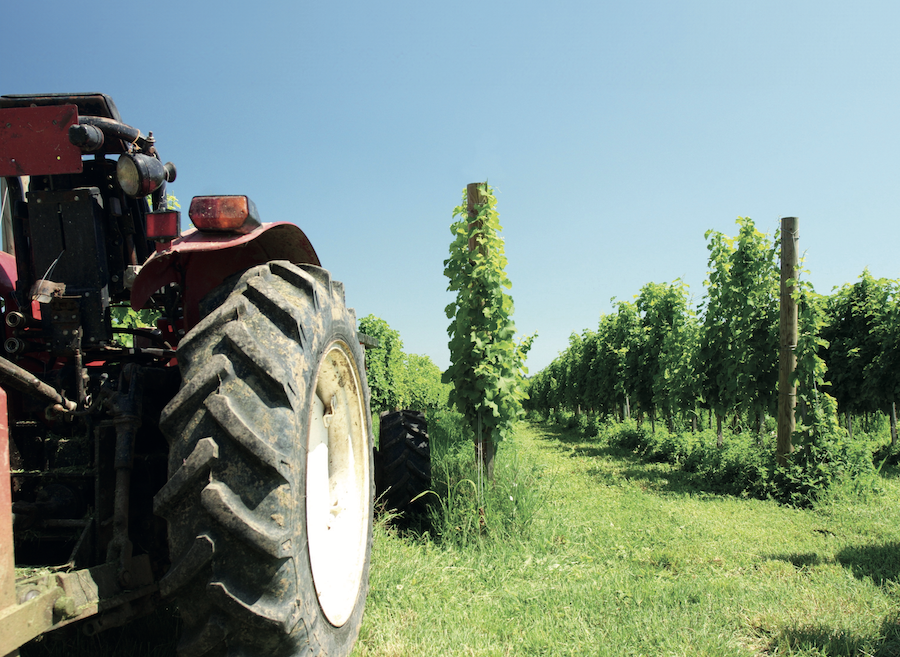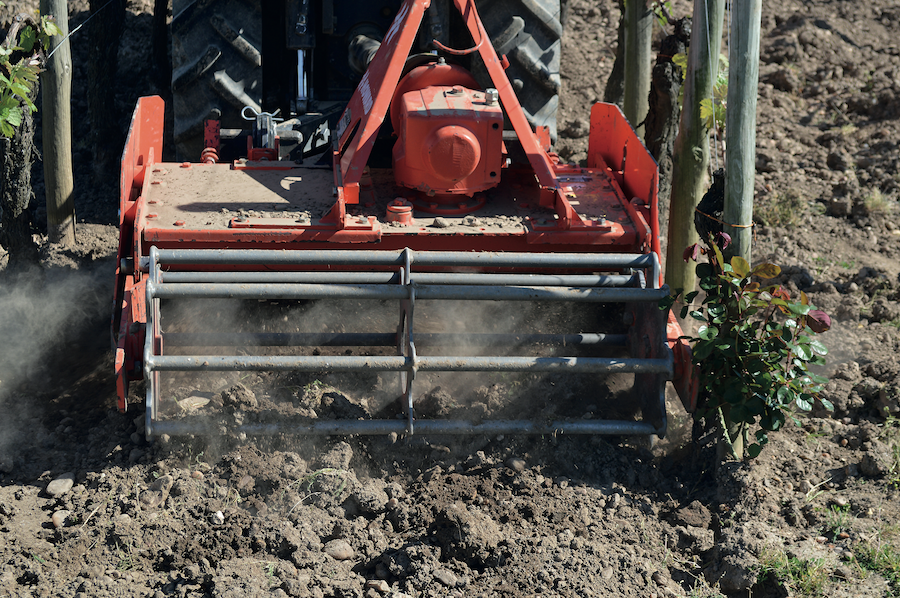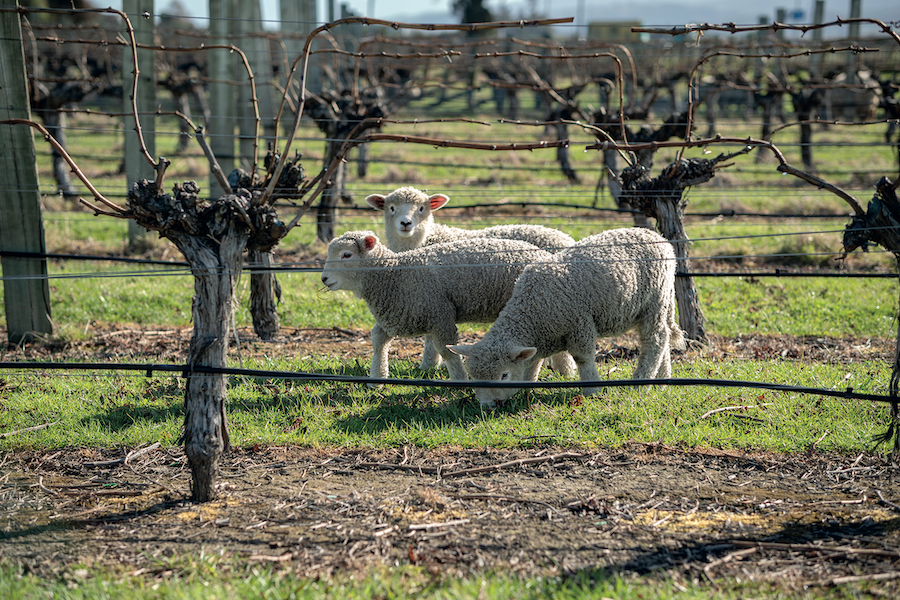Sizing up weed control options
19th February 2024
A diminishing herbicide armoury combined with a drive towards more environmentally sustainable production methods is slowly changing the face of weed control in vineyards. Hutchinsons agronomist Rob Saunders runs through some of the main options.

Good weed control is essential to the productivity of any new or established vineyard, with clear benefits from reduced competition for light, nutrients and water, plus better airflow and heat radiation in the under-vine area.
Minimising weed competition is particularly important to avoid compromising the development of newly-planted vines (see panel), while in established sites, good weed control contributes to better airflow, aiding disease management (notably botrytis during ripening later in the season) and reduces frost risk on emerging buds.
Indeed, research has shown a clear reduction in temperature around vines when long vegetation is left underneath – possibly due to cold air becoming trapped, and there being less radiative heat than on bare soil. Uncultivated bare ground has also been found to be better at re-radiating the day’s heat than a cultivated surface.
But bare soil has its drawbacks, especially as the industry’s focus shifts towards more sustainable, regenerative practices with biodiversity and soil health at their heart. The reduced herbicide armoury is further pushing growers towards a more integrated chemical and cultural weed control approach.
Chemical options
While the herbicide armoury is becoming more limited, especially given restrictions on spray timings, carefully targeted applications remain key to effective weed control, requiring only limited passes, and allowing soil to remain undisturbed, says Rob.
He recognises the value of keeping the under-vine area weed-free, but says that with the focus on soil health, it may be preferable to retain some weed cover in the under-vine strip until closer to the main frost risk period, to protect soil during wetter months and provide substrate for soil organisms during this period.
“A balance must be found though, as we cannot expect a single herbicide application to control large, well developed weed populations in one hit, therefore a staged approach using different actives may be required on particularly weedy sites.”
The residual herbicide propyzamide (as in Kerb), can be used within the vine row between October and the end of January, and is slower-acting than other chemistry, taking several weeks for growth to die back after treatment, so may provide some soil protection and substrate for soil organisms during this period.
The active controls a range of established weeds, including grassweeds, black nightshade, creeping buttercup, black bindweed, knotgrass, redshank, fat hen and chickweed.
Glyphosate remains one of the most important tools in the armoury for preparing fields before planting vines, and controlling weeds within the rows during the spring, Rob continues. The Roundup Powermax formulation of glyphosate (containing 720g/kg of active ingredient) is the main contact herbicide fully approved for use in table and wine grapes.

“On particularly weedy sites, especially those with harder to control species, such as thistles, docks and nettles, cutting back large weeds and allowing them to re-grow a little before applying glyphosate will improve the uptake and activity. Adding wetters and using appropriate water volumes will improve efficacy.”
Some weeds, like nettle, will be better controlled if glyphosate is mixed with the desiccant carfentrazone-ethyl – although he advises growers to observe the optimum ratio of these active ingredients to achieve maximum uptake by weeds. Also be aware that carfentrazone-ethyl carries a 90-day harvest interval, so should be applied by the end of flowering.
Products based on pelargonic acid or fluazifop-P-butyl offer other options, but the former has restrictions on when it can be applied, and the latter only controls a limited range of grassweeds.
Mulches
Applying an organic mulch, such as PAS-100 certified compost, or woodchips, to the under-vine area can help suppress weeds, while beneficially building soil organic matter and nutrients, says Rob.
However, neither is a complete solution, especially as the availability and cost of transporting and applying such bulky material can be prohibitive, he says. “Compost quality can also vary, and weed seedlings sometimes germinate within compost, potentially increasing, rather than decreasing, the burden.”
Young vines may derive some benefit from nutrients in compost, but Nitrate Vulnerable Zone regulations can limit application timing and quantity, depending on nutrient content, he adds.
“For woodchips or bark, beware nitrogen can get tied up by soil biology breaking down the high carbon content of woody material, leaving less available to vines. Generally, it is better to apply thinner layers of wood chip more frequently. Woodchip can also spread Armillaria mellea (boot-lace fungus).”
There is increasing interest in sowing green covers as a ‘living mulch’ underneath vines to suppress weeds, improve soil health, and benefit biodiversity. They can also shade the soil, reducing soil temperatures in extreme summer heat, to the benefit of soil organisms and reduced vine stress.
There is an added aesthetic factor too, which may be important to those who open vineyards for public events or tourism.
Rob says any species sown underneath vines must not grow too tall or vigorously, to minimise competition, allow good airflow around vines, and facilitate bunch ripening later in the season.
He cites work by viticulture researcher Michela Centinari, who identified red fescue as a useful option, most applicable where excess vine vigour is a problem. It can be tricky to establish though, as it is not particularly competitive when small, so higher seed rates are required.
Microclover is another option that Hutchinsons is looking at in a small trial with one grower in the West. The plant’s short, stunted growth habit is ideal, while it also fixes some atmospheric nitrogen into the soil.
“With any living mulch, there remains the risk that dominant weeds, such as thistle, will come through, and chemical controls are then very limited due to the risk of killing cover. It may be possible to use a weed wiper for taller species, or deploy an inter-vine mower.
“As with any green cover growing beneath vines, whether that’s microclover, red fescue, or any other cover crop, initial signs can be promising, but only time will tell if there is any impact on disease risk, frost damage, ripening, vine vigour or yield.”
Cultivations and novel approaches
Rob says there are various mechanical solutions to weed control that may be considered, although the benefits from not using chemistry must be weighed against the energy requirements, speed of operation, financial outlay, and the impact on soil health, biodiversity and crop risks.
“While herbicides offer the simplest control of weeds underneath vines, it is useful to consider what alternatives might work for individual sites, soil types and weed spectrums.”
In the right conditions, mechanical cultivation can be effective for taking out roots of dicotyledonous weeds, but Rob says it is better suited to established vineyards (four years plus) due to the risk of damaging weaker, smaller vines.
Cultivations are also best done regularly in dry, friable soils, as wet cultivations smear soil and increase the risk of regrowth. Regularly disturbing topsoil also increases erosion risk on sloping ground, releases carbon through the oxidation of organic matter, and may affect biodiversity, such as ground-nesting bees and soil biology.
Electric weeders are an alternative option; they were first tried in the 1950s, but failed to catch on commercially. However, electric weeders can be effective on fleshy weeds with tap roots, such as thistle or dock, although less so on grasses, he says.
Electric weeders are safe to use around vines, due to the woody stems – although systems do require large amounts of power, especially if attempting to treat a wide swathe, which may raise questions over their sustainability, he adds.
Similar questions may apply to gas-powered flame weeders, which can also be slow and require specialist technology that may be heavy and prone to technical issues.
Water weeders are another approach that has been developed, using either high pressure water jets or steam to destroy weeds. Operational speed, effectiveness and disturbance of the soil surface are potential issues though.
Grazing
Overwinter sheep grazing in the vineyard is a popular option for many growers, that has several benefits, Rob explains.
“Sheep do a great job of tightly grazing down weeds and grass, which keeps vineyards looking tidy and means spring herbicide treatments are more effective. Grazing stimulates young fresh growth to take up actives, and reduces the application shadow that can occur around tall weeds or clumps of grass. I like it as a technique.”
Grazing in winter means there is no risk to foliar growth, although he suggests grazing is probably not suitable around very young vines. Copper toxicity is also a risk in sheep, so avoid grazing where copper has been recently applied in the vineyard.
Lack of adequate fencing is often a concern; however, this can be easily overcome with temporary electric fencing, which is relatively quick to install and move with a barrow or ATV-mounted reel system, such as those made by Rappa.

“Grazing agreements are usually on an ad-hoc basis with local farmers, where you might be able to borrow sheep for little or no cost. Charging for providing grazing is unlikely.”
Weed control in new vineyards
In most situations, ground destined for planting a new vineyard will be sprayed off with glyphosate before ploughing; however, Rob says a further weed flush is likely as temperatures rise in the spring, so a follow-up treatment in early April may be necessary.
Grow tubes around vines allow herbicides to be applied safely post-planting, while protecting vines from rabbit damage.
Make sure a functioning herbicide sprayer is ready, as weeds can take hold quickly in warm soils and compete with new vines for light, water and nutrients.
Biodegradable membranes laid down straight after planting offer effective non-chemical weed suppression, and help to conserve moisture and warm the soil, he adds. Some occasional hand roguing of pernicious weeds (e.g. thistles) may still be needed though, and hand-weeding of planting holes is also important given limited chemistry.
